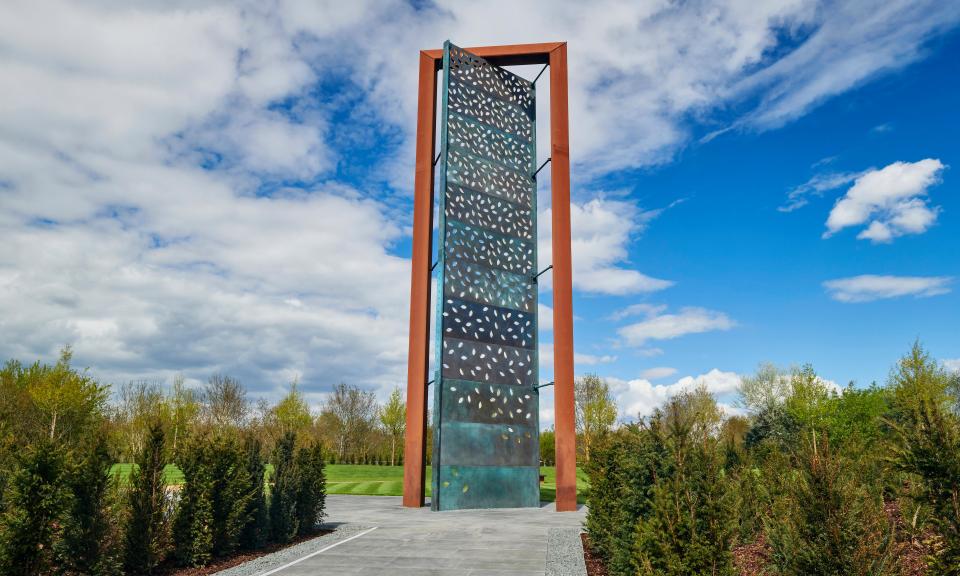New police memorial honours officers killed in the line of duty

If PC Fiona Bone had turned a different way, if she had been sick that day, if her degree in film production studies had led to more work, her father, Paul, would have not spent the last nine years grieving.
For officers and their families, the difference between life and death in policing can be terribly slight.
In September 2012, accompanied by PC Nicola Hughes, 23, Bone, 32, responded to a call about a burglary in Mottram, Greater Manchester.
It had been placed by a gangland killer who was a fugitive from the police, who had lured officers into a murderous trap. He unleashed a gun and grenade attack, vicious by the standards of violence in British inner cities. “I lost a good friend and companion. The mere fact she was a police officer did not come into it,” said Paul Bone.
On Wednesday a new memorial will be officially unveiled to honour those such as Fiona Bone, PC 12601 in Greater Manchester police, killed in the line of duty. It is at the national memorial arboretum in Staffordshire and it took seven years to raise the £4.5m needed for it to be built.
The memorial will be much bigger than the one on the Mall in central London, allowing families peace, space and time to reflect and find solace.
Bone, 73, said: “For the greater police family, the memorial at the arboretum will be much better because it brings home to the general public how many policemen have actually lost their lives.”
Since the founding of the Bow Street runners in 1749, the forerunner to modern policing, 1,500 officers have died due to acts of violence at work, said the trust behind the memorial.
PC Fiona Bone had studied film production, but decided on a career in policing. “I am proud she was a police officer and died doing her duty,” said her father. He added: “She was doing a job she wanted to do – she liked helping people. I was proud she wanted to serve her community.”
Work on the new memorial began last April, with Bone breaking the first ground: “I helped dig the hole that started it all. It was very hard – it was matted soil.”
Spearheading the effort has been Sir Hugh Orde, former leader of the police chiefs in England and Wales and former chief in Northern Ireland, who was once tipped to be Met commissioner.
Orde said: “When people go there, they fall silent. It is very hard not to be emotional. It is a simple but powerful design.”
Punching up from the matted Staffordshire soil are two 12 metres tall brass pillars with small holes representing lost officers. It is housed in tree-lined grounds meant as a comfort to the bereaved.
Bone said: “When you are approaching the memorial, you go in through the main entrance, on to the main footpath, and you can see it vaguely in the distance. As you approach it, it gets bigger and more spectacular. And you walk up to it and it is absolutely spectacular, especially when the sun is on it.”
The unveiling comes during a difficult year for policing, when the worst of the service has been on display; a murder, a manslaughter, gross breaches of trust straining public confidence.
The police have struggled to talk about their biggest daily challenges. Increasingly, those challenges have not just been facing criminals. They have also had to deal with mental health, the strain of the job, the scores of daily attacks on officers – 25 a day in London alone – and the continuous fear of not going home.
Orde said: “The main thing is those who have fallen, but it is a bit about the British model of policing. Ninety per cent of officers do not carry a gun and are close to their communities. A bit of it is about putting the British model of policing back on the map, so people realise the sacrifices made by citizens protecting fellow citizens. This embeds the history in a very physical and inspirational way.”
The physical memorial will be supported by a digital memorial, telling the lives of those officers killed.
Bone said: “You mainly feel the loss of all those police officers over the years. All their memories will be gathered in the one place.”
He said that the memorial, no matter how stunning, would always be second best: “I like going down there to visit, seeing the various trees. But to be honest, I’d prefer Fiona back.”
For Bone, processing the tragedy was as difficult nearly a decade on as the day he heard the catastrophic news. “It gets a bit more faded, but it’s never easier.”

 Yahoo Finance
Yahoo Finance 